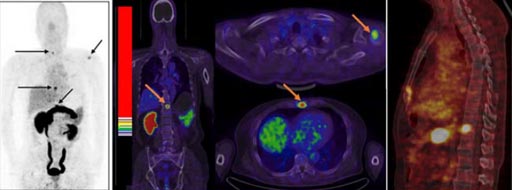New Radiotracer Helps Diagnose Prostate Cancer Faster
By MedImaging International staff writers
Posted on 17 Feb 2017
A new study describes a radioactive tracer that targets two different biomarkers, gastrin-releasing peptide receptor (GRPR) and integrin αvβ3, which often indicate prostate cancer (PC).Posted on 17 Feb 2017
Developed by researchers at Peking Union Medical College Hospital and the U.S. National Institute of Biomedical Imaging and Bioengineering, the new dual-receptor 68Ga-labeled heterodimeric peptide BBN-RGD radiotracer was designed to identify tumors at all PC stages by binding to the target receptors or biomarkers in primary tumors, metastatic lymph nodes, and metastatic bone lesions.

Image: The new tracer shows tumors in a 64-year-old man with PC (Photo courtesy of NIBIB).
The radioactive atoms enable positron emission tomography (PET) or single photon emission computed tomography (SPECT) scanners to image the areas where the tracers have collected in large numbers. In a Phase I clinical trial in 13 PC patients, the tracer was able to successfully identify three of four primary tumors, all 14 metastatic lymph nodes and, significantly, was also able to identity all 20 of the metastatic bone lesions. In contrast, only two of the primary tumors, five lymph nodes, and 12 bone lesions were positive using the 68Ga-BBN single receptor tracer. The study was published in the February 2017 issue of The Journal of Nuclear Medicine.
“We are far from finding one method to diagnose and monitor prostate cancer, but this is a step in that direction. Targeting multiple biomarkers could potentially allow us to identify prostate cancer at its early stages as well as after metastasis in one scan,” said senior author Xiaoyuan Chen, PhD, chief of the laboratory of molecular imaging and nanomedicine at NIBIB. “Dual-receptor targeting tracers could one day be the primary method for diagnosing and monitoring prostate cancer, reducing the amount of medical scans a patient would be forced to undergo and streamlining the diagnostic and therapeutic process.”
A variety of imaging techniques and tests are currently used to diagnose and monitor prostate cancer, including prostate specific antigen (PSA) blood tests, magnetic resonance imaging (MRI), PET and SPECT, and computerized tomography (CT) scans. Each method has strengths and weaknesses, but there is no single method that is able to successfully identify and monitor primary tumors, metastatic lymph nodes, and bone lesions, which can cause the patient to undergo unnecessary treatments or painful biopsies.














